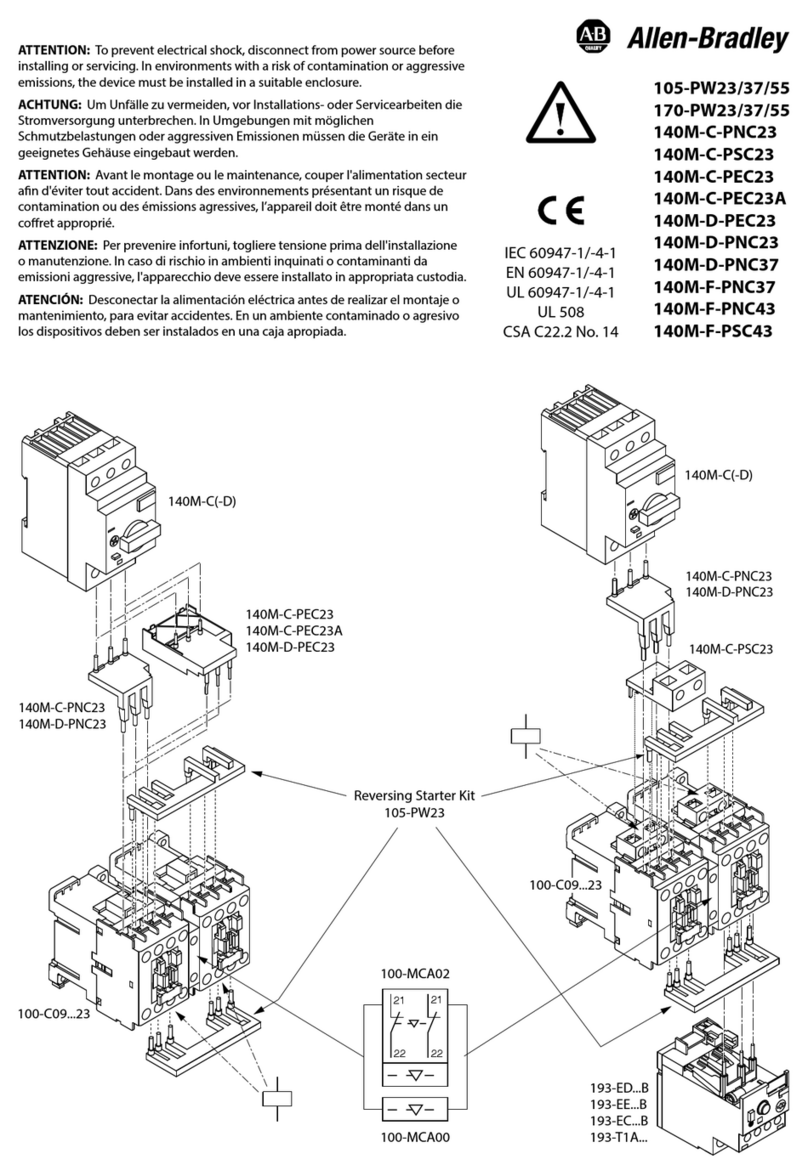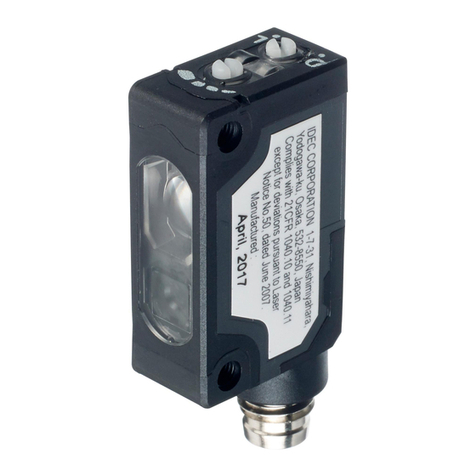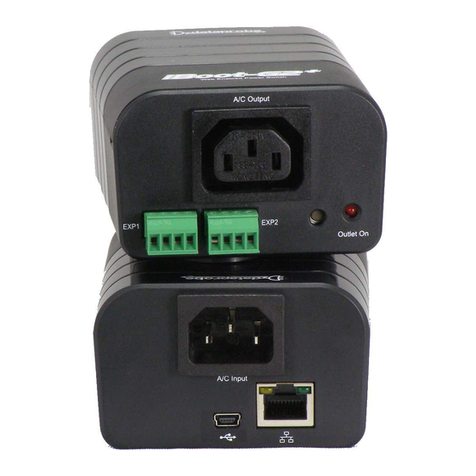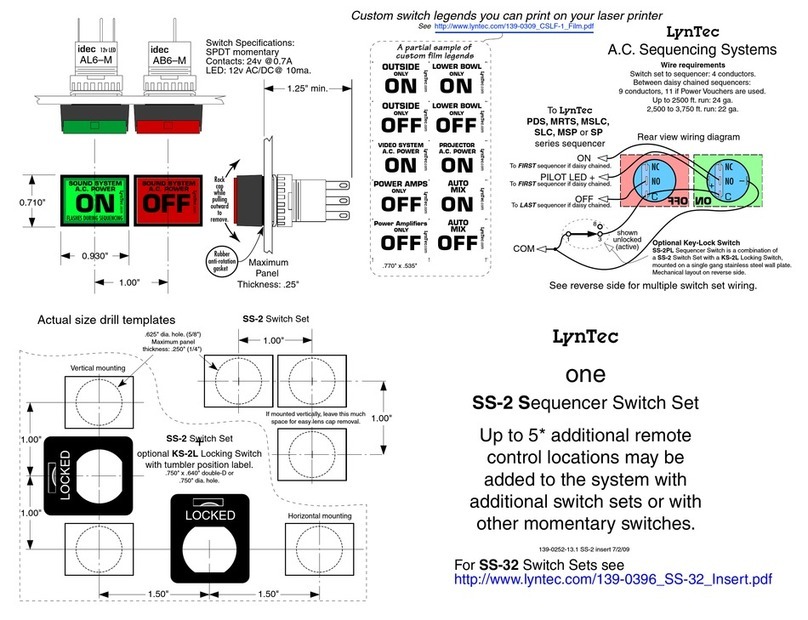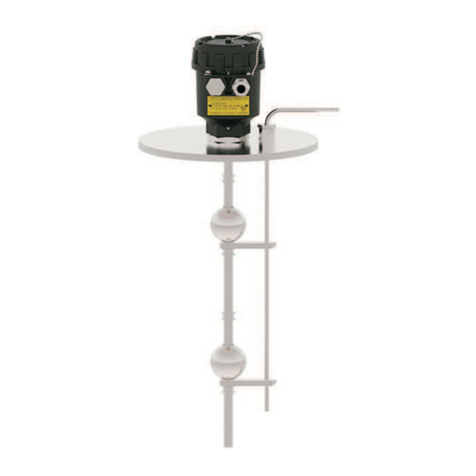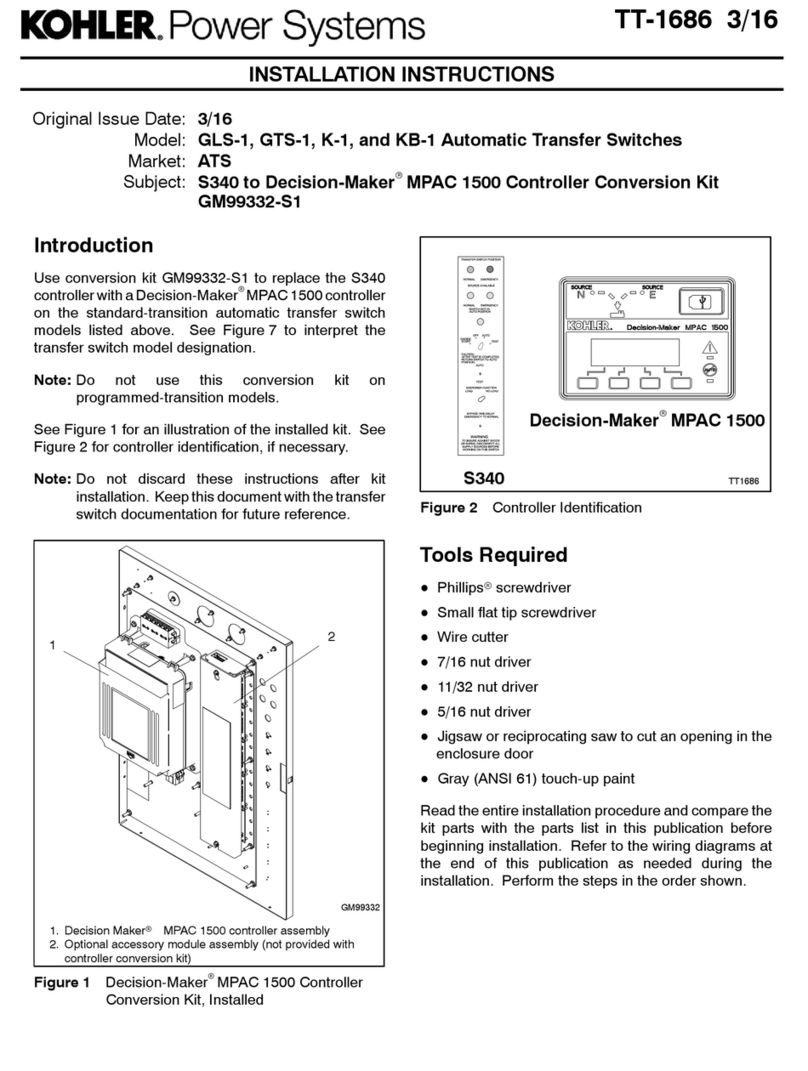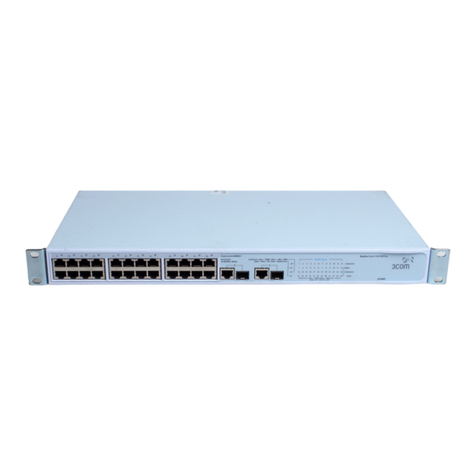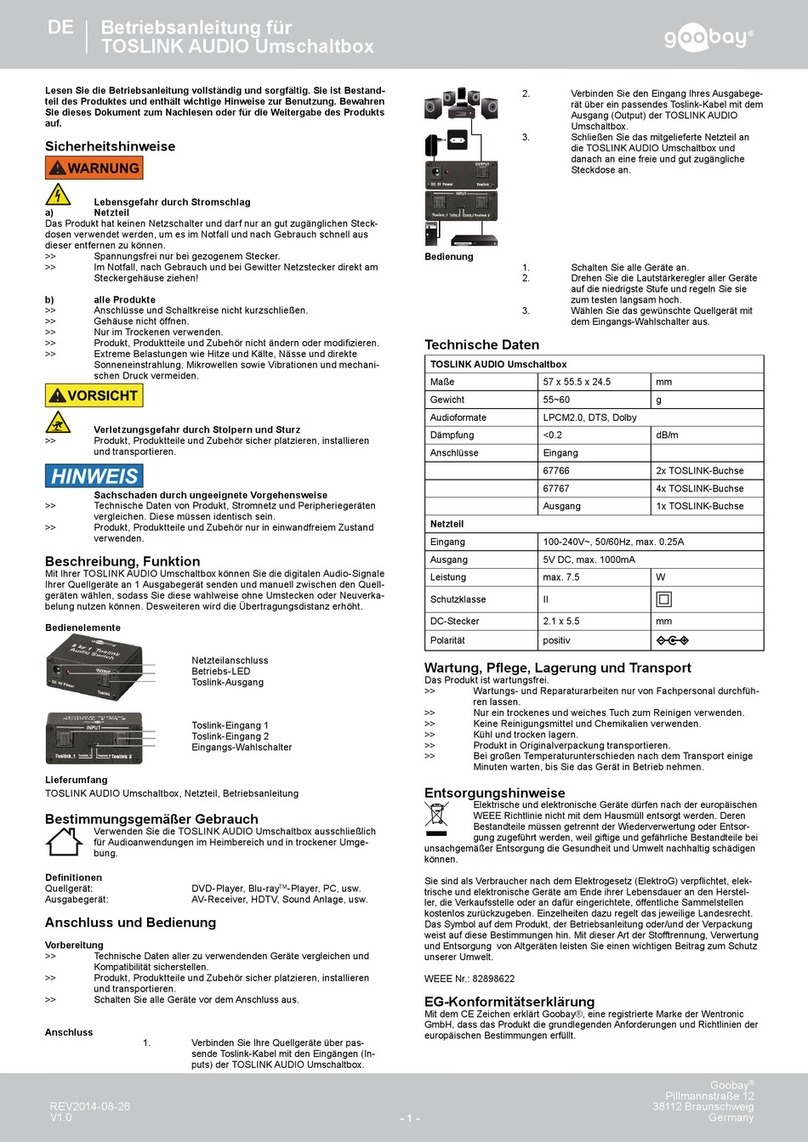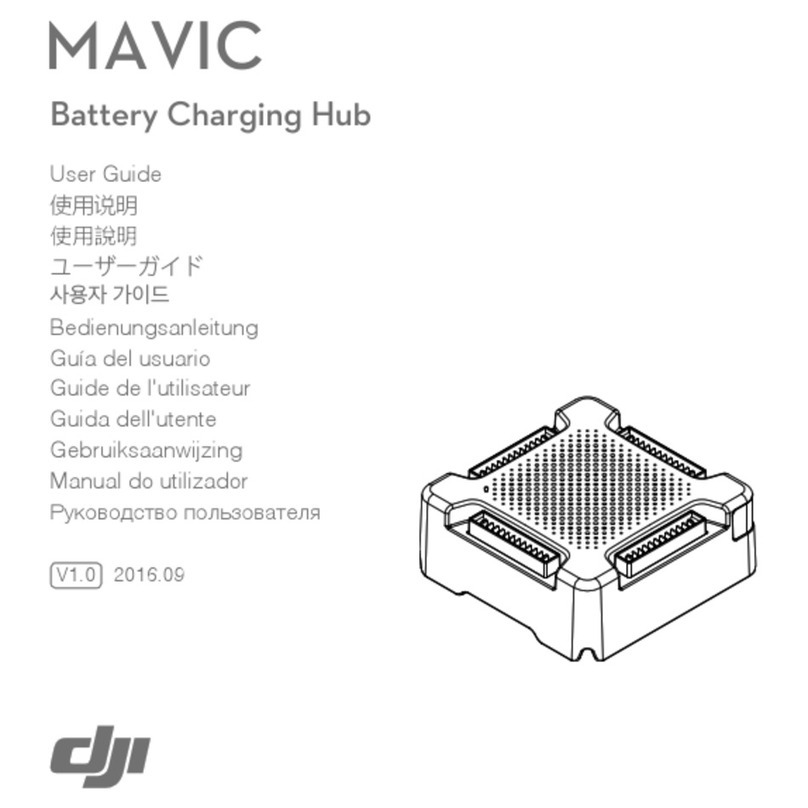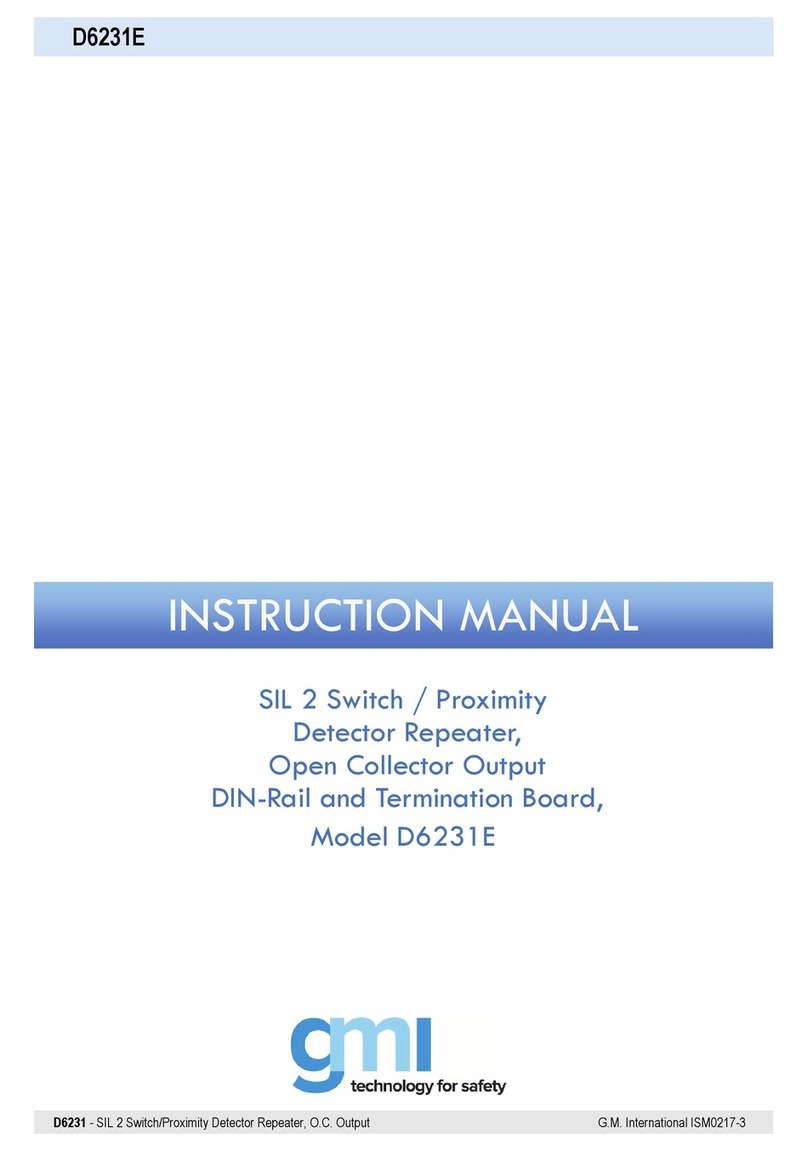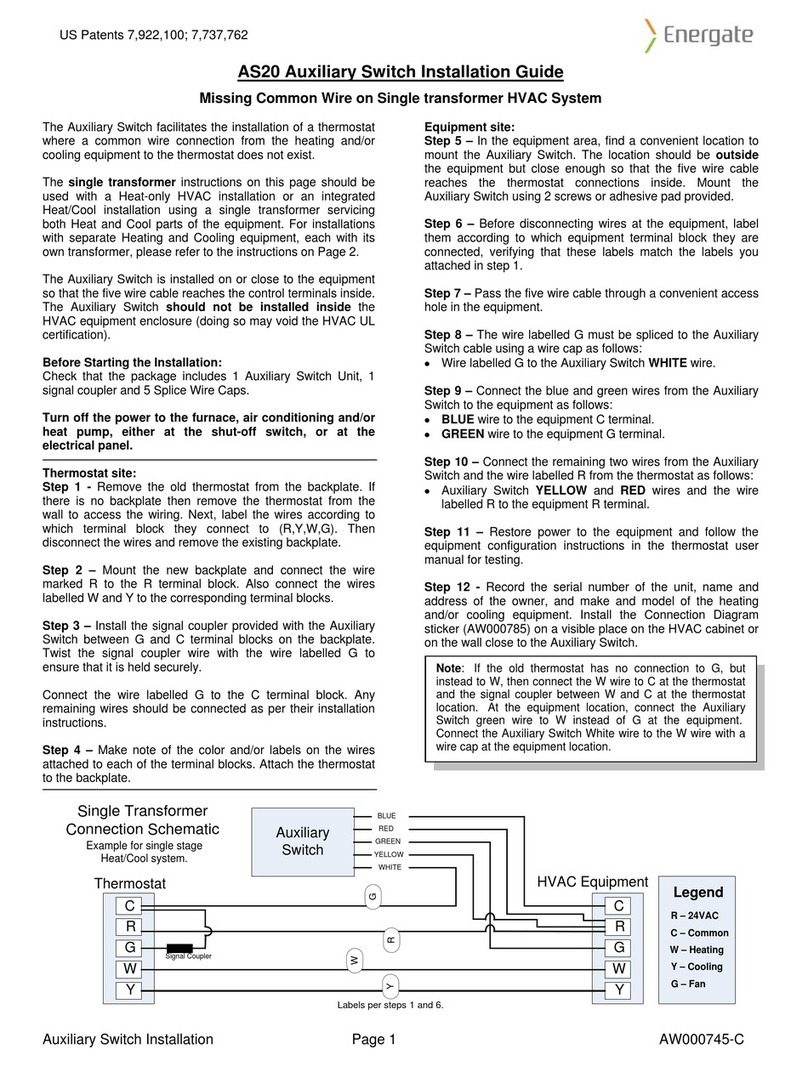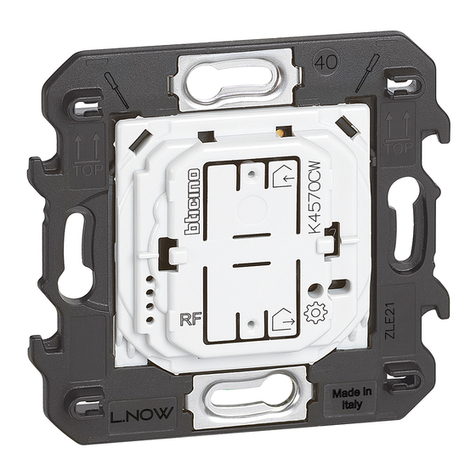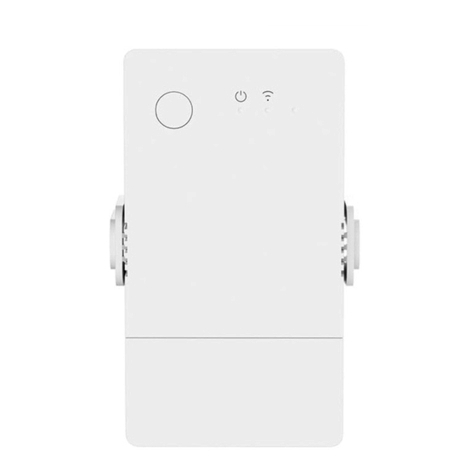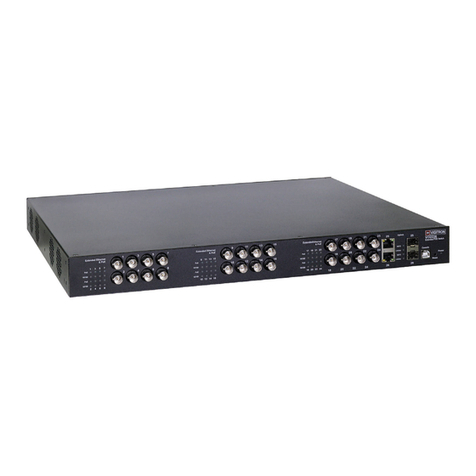Crystal Vision M-SAFESWITCH-2 User manual

Crystal Vision M-SAFESWITCH-2/2L User Manual
M-SAFESWITCH-2/2L User Manual R1.4 121 July 2022
Contents
1Introduction 4
2Block Diagram 6
3Hardware Installation 7
3.1 Rear module signal IO 7
4I/O Configuration 8
4.1 Configuring the Ethernet Interfaces 8
4.2 Enabling Inputs & Outputs 10
4.3 Select I/O Protocol 11
4.4 Receiving an IP Flow 12
4.5 Transmitting an IP Flow 13
5Status 15
5.1 Input Video status 15
Video Status 15
5.2 Input Audio status 16
Audio Status 16
5.3 Status Delay 16
5.4 Network Status & Statistics 17
Flow Statistics 17
Network In/Protect Network In pkts 17
6Safe Switch Processing 19
6.1 A and B Sources 19
6.2 Auto Switch Configuration 20
Video & Network errors 20
Audio errors 21
6.3 Switching Modes 22

Crystal Vision M-SAFESWITCH-2/2L User Manual
M-SAFESWITCH-2/2L User Manual R1.4 221 July 2022
6.4 Output Routing 23
7Output Legalising (M-SAFESWITCH-2L
only) 24
8References and Output Timing 25
8.1 References 25
Status 25
Reference configuration 26
PTP Configuration 26
PTP Statistics 27
8.2 Output timing 27
Output Timing 27
8.3 Frame delay 28
9Traffic Shaping Profile 29
9.1Traffic Shaping Profiles 29
10 Input Format, Input Loss and Test
Pattern Options 30
10.1 Input Format and On Loss of Input 30
10.2 Internal Test Patterns 31
10.3 Audio mute 31
11 Unicast Flow Configuration 32
12 Basic Trouble Shooting 34
12.1 No input or output signals present 34
12.2 Errors in the IP flow’s video content 34
12.3 IP flows keep stopping after a few minutes 34
13 Specification 35

Crystal Vision M-SAFESWITCH-2/2L User Manual
M-SAFESWITCH-2/2L User Manual R1.4 321 July 2022
Revision 1 Added new features: 60 frames additional Source B delay, switch tolerance and third
output.
27/01/21
Revision 2 Updated block diagram and specs to clarify only two inputs available when used with
3Gb/s.
19/02/21
Revision 3 Added M-SAFESWITCH-2L version. Added VR07 relay bypass. 13/04/21
Revision 4 User interface screen shots updated to align with V2.3 MARBLE-V1 and V1.19
Vision 3 software releases. Added new audio switching, audio monitoring and audio
mute features. Added new preset features. Updated use of flow terminology.
21/07/22

Crystal Vision Introduction
M-SAFESWITCH-2/2L User Manual R1.4 421 July 2022
1 Introduction
M-SAFESWITCH-2 and M-SAFESWITCH-2L are 3G/HD/SD-SDI intelligent dual clean switch
software apps that run on the MARBLE-V1 media processor – purpose-built GPU/CPU
hardware that fits in the Vision frame. Featuring two independent 2x1 switches, source A to B
switching can be triggered automatically based upon user configurable input fault conditions,
or manually – useful for planned maintenance on the primary programme channel.
Like all MARBLE-V1 video processing software apps, the M-SAFESWITCH-2 and M-
SAFESWITCH-2L can be used with IP (ST 2022 or ST 2110 video), with SDI or with both IP
and SDI at the same time (thereby providing gateway functionality).
The M-SAFESWITCH-2 and M-SAFESWITCH-2L will be referred to collectively as M-
SAFESWITCH-2/2L throughout this manual.
M-SAFESWITCH-2:
•Dual 2x1 clean switch for 3G/HD/SD SDI or IP video
•Switch from source A to B automatically based upon user configurable input
fault conditions, or manually
•Four video inputs for input source selection to each switch
•Three video outputs (two SDI or IP, one IP only) routable to the output from
each switch or direct to inputs for monitoring
•Monitor and switch upon input not present, input format error, video black, video
frozen, video error, network error, audio channels missing, audio channels silent
•Latch the switch to source B, or automatically return to A after the source has
been free from error for a user adjustable delay time
•Ten frames adjustable video input delay per input, in one frame increments
•Additional Source B frame delay of up to 60 frames to compensate for systems
where Source A is subjected to a long delay e.g. arrival from a graphics system
M-SAFESWITCH-2L:
•As above but with RGB legalisers on each output
•When enabled, legalisers clip RGB to be within the limits specified by the EBU
R 103 recommendation
•Choice of clipping mode: Constant Hue, Desaturation or simple Hard / Medium /
Soft clip

Crystal Vision Introduction
M-SAFESWITCH-2/2L User Manual R1.4 521 July 2022
Common MARBLE-V1 feature set:
•Supports SMPTE ST 2022-6 and ST 2022-7 protocols and video within ST 2110
(supporting ST 2110-10, -20 and -21 standards)
•10GbE SFP+ connectivity supporting 1310nm single-mode long range and 850nm
multi-mode short range fibre
•Input and output present, black and frozen monitoring
•Input video and network error detection
•Input audio group monitoring
•IP inputs tolerant of any input packet distribution
•Instant clean switching between input flows, whatever their timing
•IP flow monitoring including packet loss, duplicated packets and packet delay
variation
•Internal test patterns
•Sub frame output timing adjustment locked to chosen reference source
•Ten frame adjustable video output delay per output, in one frame increments
•Choice of multiple timing sources with fail-over: PTP and two analogue Black and
Burst or tri-level syncs references via Vision frame
•Support for unicast and multicast transmission
•Full range of VLAN support
•Supports IGMP V1, V2 and V3
•Supports 31 video standards
•Flexible remote control and monitoring using frame integrated control panel,
VisionPanel remote control panel, ASCII and JSON protocols, SNMP and the web
browser-based VisionWeb Control
•Dual slot card allowing 10 cards in Vision 3 frame

Crystal Vision Block Diagram
M-SAFESWITCH-2/2L User Manual R1.4 621 July 2022
2 Block Diagram
M-SAFESWITCH-2
N.B. M-SAFESWITCH-2L as above but with the addition of RGB legalisers on each of the
outputs

Crystal Vision Hardware Installation
M-SAFESWITCH-2/2L User Manual R1.4 721 July 2022
3 Hardware Installation
The potentiometers on the card are factory set and should not be adjusted. There are no
user-selectable links.
The app based MARBLE-V1 cards are intended for use only in the Crystal Vision ‘Vision’
frame range and not in older style frames such as ‘Indigo’.
Insert the card by pushing the white handle on the card edge, being careful to ensure the card
is inside the guide rails. Remove it by pulling the metal hook. Do not force the card if
resistance is met as the card may not be correctly aligned with the rear connectors.
Ensure that the Vision frame has the correct rear module fitted. Only the VR04, VR06 and
VR07 rear modules offer the correct input/output functionality for the M-SAFESWITCH-2/2L
apps.
The cards and rear modules can be inserted and removed without powering down the frame.
3.1 Rear module signal IO
VR04
VR06
SDI 1: SDI In 1
SDI 2: SDI In 2
SDI 3: SDI In 3
SDI 4: SDI In 4
SDI 5: SDI Out 1
SDI 6: SDI Out 2
Eth 1 to 4: 10GbE video
over IP I/O
D-Type on VR06: No
connection
VR07 SDI relay bypass
protection,in the event
of power or card
malfunction: SDI 1 to 5,
SDI 2 to 6
VR07

Crystal Vision I/O Configuration
M-SAFESWITCH-2/2L User Manual R1.4 821 July 2022
4 I/O Configuration
VisionWeb web browser control software is recommended for the configuration of the
MARBLE-V1 software apps. This is achieved by entering the IP address of the frame into a
web browser (10.0.0.201 on Ethernet port 1 of the frame by default). See the Vision 3 frame
manual for more information on VisionWeb and frame configuration and operation.
Example ‘VisionWeb’ homepage
4.1 Configuring the Ethernet Interfaces
MARBLE-V1 ST 2022 and ST 2110 video over IP flows are received and transmitted using
the VR04/VR06/VR07 10GbE network interface connections. VR06 provides two network
interfaces while the VR04 and VR07 provide four. A typical usage case is to use Eth 1
interface for the ‘primary’ IP traffic and Eth 2 for the ‘protect’. The additional Eth 3 and 4
interfaces on the VR04 and VR07 allow input flows to be separated from output flows.
Within each Ethernet interface there are six virtual interfaces. These are useful for software
apps which process six individual IP flows, such as the IP gateways, as each flow can be
assigned to its own unique IP address. It is, however, possible to use the same virtual
interface for all input and output flows. If using SDI I/O with an analogue reference no virtual
interfaces will need configuring.

Crystal Vision I/O Configuration
M-SAFESWITCH-2/2L User Manual R1.4 921 July 2022
In a fully IP environment, the following example shows how the M-SAFESWITCH-2/2L
primary and protect input and output flows could be assigned to individual virtual interfaces.
As previously mentioned, it is also possible to assign all flows to the same interface.
Flow Inputs
Eth 1:1 Primary IP Input 1 Eth 2:1 Protect IP Input 1
Eth 1:2 Primary IP Input 2 Eth 2:2 Protect IP Input 2
Eth 1:3 Primary IP Input 3 Eth 2:3 Protect IP Input 3
Eth 1:4 Primary IP Input 4 Eth 2:4 Protect IP Input 4
Flow Outputs
Eth 1:5 Primary IP Output 1 Eth 2:5 Protect IP Output 1
Eth 1:6 Primary IP Output 2 Eth 2:6 Protect IP Output 2
Eth 1:6 Primary IP Output 3 Eth 2:6 Protect IP Output 3
Alternatively, if using the VR04 or VR07, the IP Flow Outputs can be separated onto Eth 3
and 4.
Eth 1:1 example IP
parameters. Hover mouse
above control labels on
VisionWeb UI to show
control hints

Crystal Vision I/O Configuration
M-SAFESWITCH-2/2L User Manual R1.4 10 21 July 2022
4.2 Enabling Inputs & Outputs
By default M-SAFESWITCH-2/2L inputs and outputs are disabled. Use the Enable control
within the Input and Output menus to enable them.
To prevent exceeding the network interface and processing bandwidth, 3G video inputs are
supported on inputs 1 and 3 only.
M-SAFESWITCH-2 Input Enable
M-SAFESWITCH-2 Output Enable

Crystal Vision I/O Configuration
M-SAFESWITCH-2/2L User Manual R1.4 11 21 July 2022
4.3 Select I/O Protocol
M-SAFESWITCH-2/2L supports SDI and uncompressed video over IP protocols ST 2022 and
ST 2110-20. It is possible to mix protocols between input and outputs. For example, an ST
2022 input can be output as SDI on Output 1 and ST 2110 on Output 2.
Once the inputs and outputs have been enabled, the required Protocol can be selected using
the drop down menus within the Input and Output control tabs. The protocol type will need
selecting for each input and output.
M-SAFESWITCH-2 Input Protocol Selection
IP output flow transmission supports both Block Packing Mode (BPM) and General Packing
Mode (GPM) for ST 2110-20 encapsulation. BPM, which packs multiple (up to 7) 180 byte
blocks into an RTP payload, is a restricted subset of GPM, and GPM is the more general
case.

Crystal Vision I/O Configuration
M-SAFESWITCH-2/2L User Manual R1.4 12 21 July 2022
4.4 Receiving an IP Flow
M-SAFESWITCH-2/2L receives ST 2022 or ST 2110-20 video over IP flows using the 10GbE
network interfaces on the VR04/VR06/VR07 Vision frame rear connector. Typically Eth 1 is
used for receiving and transmitting the ‘primary’ IP flows, with Eth 2 being used for the
‘protect’ in -7 protect applications.
The following example shows an M-SAFESWITCH-2/2L configured to receive Input 1 using
SMPTE ST 2022-7 protocol. When selecting ST 2022-7 it is necessary to configure both the
‘Network In’ and ‘Protect Network In’.
M-SAFESWITCH-2 Input 1 IP Flow In
The controls highlighted in the above configuration show Input 1 of the M-SAFESWITCH-2/2L
set to receive the ‘main’ flow packets on Ethernet Interface 1:1 and ‘protect’ packets of the ST
2022-7 protocol on 2:1. In this example multicast IP addresses are in use.
To successfully receive a flow, all IP parameters must agree with those of the transmitter. If
receiving ST 2110, the 2110 payload type and 2110 format will need to match the transmitter.

Crystal Vision I/O Configuration
M-SAFESWITCH-2/2L User Manual R1.4 13 21 July 2022
4.5 Transmitting an IP Flow
M-SAFESWITCH-2/2L transmits ST 2022 or ST 2110-20 video over IP flows using the 10GbE
network interfaces on the VR04/VR06/VR07 Vision frame rear connector. Typically Eth 1 is
used for receiving and transmitting the ‘primary’ IP flows, with Eth 2 being used for the
‘protect’ in -7 protect applications.
The following example shows an M-SAFESWITCH-2 configured to transmit Output 1 using ST
2110-20 GPM Protect protocol. When selecting a protect protocol it is necessary to configure
both the ‘Network Out’ and ‘Protect Network Out’.
M-SAFESWITCH-2 Output 1 IP Flow Out
The controls highlighted in the above configuration show Output 1 of the M-SAFESWITCH-2
routing the Safe switch 1 processing block to Ethernet Interface 1:5 and 2:5 using ST 2110-20
GPM Protect protocol. In this example multicast destination addresses are being used for the
main and protected flows which, if required, could be replaced by single point unicast
addresses.

Crystal Vision I/O Configuration
M-SAFESWITCH-2/2L User Manual R1.4 14 21 July 2022
VLANs, ports and Time To Live (TTL) should be configured as per the network switch
requirements.
If required a valid SSRC (Synchronisation source identifier) can be entered, otherwise left
blank or set to 0 will accept all.
When transmitting ST 2110 the required payload type value should be set. The value for
payload type is arbitrary and decided by the user. For example, value 100 could be used to
indicate 1920x1080i 50Hz content and value 101 used to indicate 625i 50Hz content.

Crystal Vision Status
M-SAFESWITCH-2/2L User Manual R1.4 15 21 July 2022
5 Status
5.1 Input Video status
Input video status
Video Status
Enabled LED: Green when input is enabled, otherwise off
Present LED: Green when input is present, otherwise off
Time present: Length of time input has been present
Format: Read only text showing video format e.g. 1920x1080i 50Hz
Video black LED: Yellow if input is full frame black, otherwise off
Video frozen LED: Yellow if input is frozen, otherwise off
Video error LED: Red if CRC errors detected at input, otherwise off
Ancillary data error LED: Red if ANC data errors detected at input, otherwise off
Network error LED: Red if lost or duplicate packets are detected on primary or protect
network input

Crystal Vision Status
M-SAFESWITCH-2/2L User Manual R1.4 16 21 July 2022
5.2 Input Audio status
Input audio status
Audio Status
Audio Group 1 to 4 present LED: Green when audio groups present, otherwise off
Audio Channel 1 to 16 present LED: Green when audio channels present, otherwise
off
Audio Group 1 to 16 silent LED: Yellow when audio channels silent (-93dBFS trigger
point), otherwise off
The equivalent Flow Out status is also provided for present, format, video black and video
frozen.
5.3 Status Delay
Audio silent, video black and video frozen status can be prevented from triggering until a user
selectable delayed period between 1 to 120 seconds has expired. These controls are located
within the ‘Defaults’ tab and are also duplicated on each of the ‘Safe Switch’ tabs.
Status delay

Crystal Vision Status
M-SAFESWITCH-2/2L User Manual R1.4 17 21 July 2022
5.4 Network Status & Statistics
Input network status
Enabled LED: Green when input is enabled, otherwise off
Present LED: Green when input is present, otherwise off
Error LED:Red if lost or duplicate packets detected at input, otherwise off
Input 1 flow network statistics
Flow Statistics
Protect %: Percentage of packets used from the ‘protected’ network input
Skew: Difference in packet arrival. –ve indicates protect packets are arriving first
Network In/Protect Network In pkts
Lost: Number of lost packets

Crystal Vision Status
M-SAFESWITCH-2/2L User Manual R1.4 18 21 July 2022
Duplicate: Number of duplicate packets
Min gap: Minimum gap between packets (nSec)
Max gap: Maximum gap between packets (nSec)
Mean gap: Mean gap between packets of a frame (nSec)

Crystal Vision Safe Switch Processing
M-SAFESWITCH-2/2L User Manual R1.4 19 21 July 2022
6 Safe Switch Processing
M-SAFESWITCH-2/2L features dual independent 2x1 switches. Source A to B switching can
be triggered automatically based upon user configurable input fault conditions, or manually –
useful for planned maintenance on the primary programme channel.
6.1 A and B Sources
Within the Safe Switch control tabs, select the inputs to be used for Source A and B for each
switch. To prevent exceeding the network interface and processing bandwidth, 3G video
inputs are supported on inputs 1 and 3 only. For this reason default pairing is Input 1 and 3 for
Safe Switch 1 in order to provide full 3G I/O for this switch.
Switch Source selection
In addition to the up to 10 frames input flow delay adjustment, up to 60 frames of delay can be
applied to Source B, allowing input timing alignment should Source A be subjected to lengthy
delays e.g. arrival from a graphics system.
Source B frame delay
This manual suits for next models
1
Table of contents
Other Crystal Vision Switch manuals
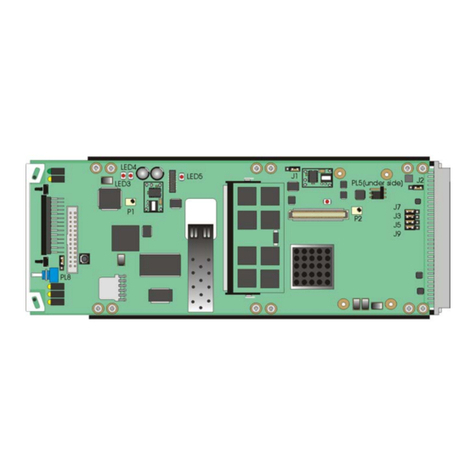
Crystal Vision
Crystal Vision Safe Switch 3G User manual
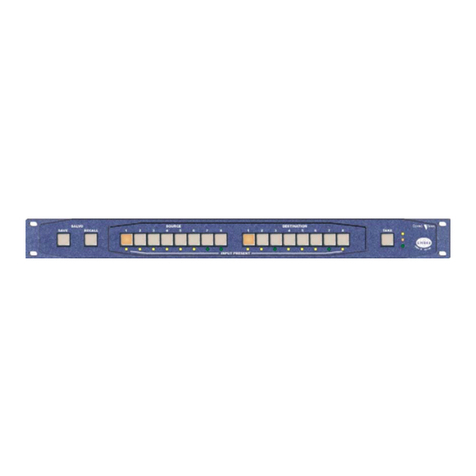
Crystal Vision
Crystal Vision SW808 User manual
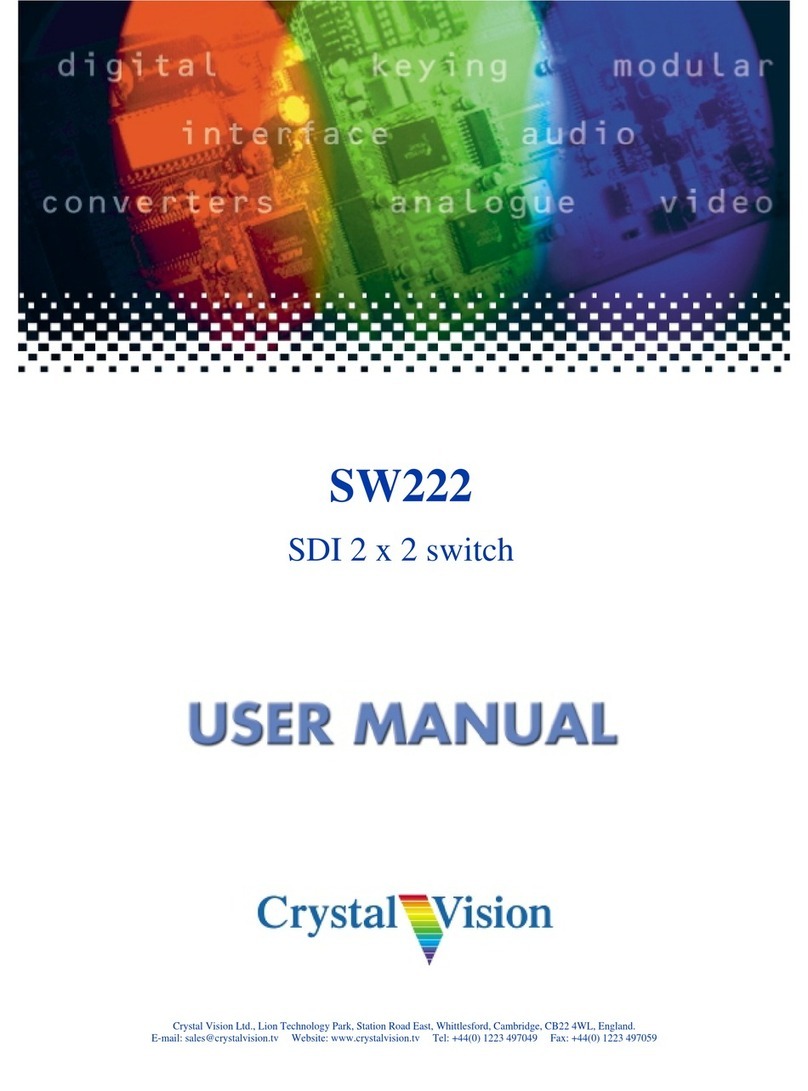
Crystal Vision
Crystal Vision SW222 User manual

Crystal Vision
Crystal Vision Indigo ViViD 3G User manual
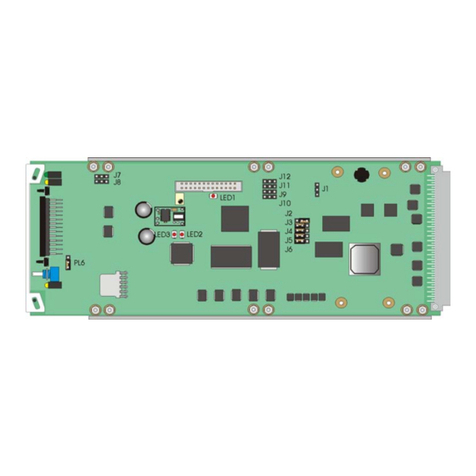
Crystal Vision
Crystal Vision Indigo SW221 3G User manual
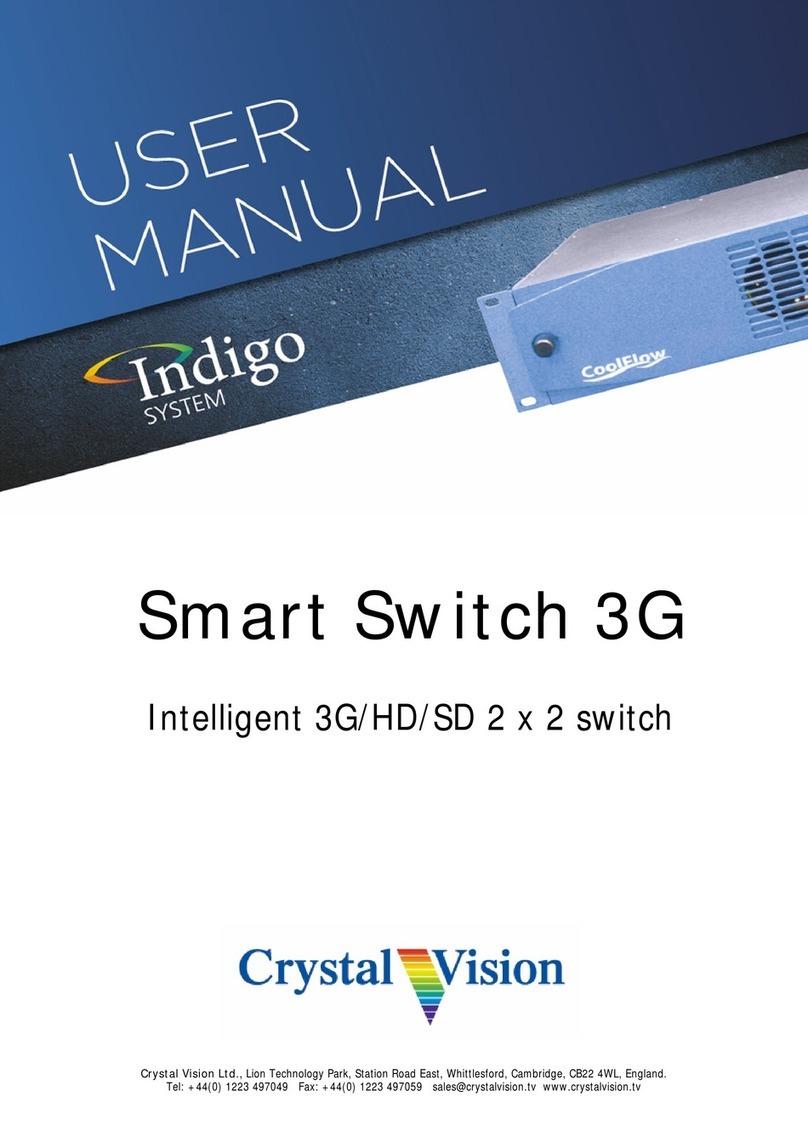
Crystal Vision
Crystal Vision Indigo Smart Switch 3G User manual
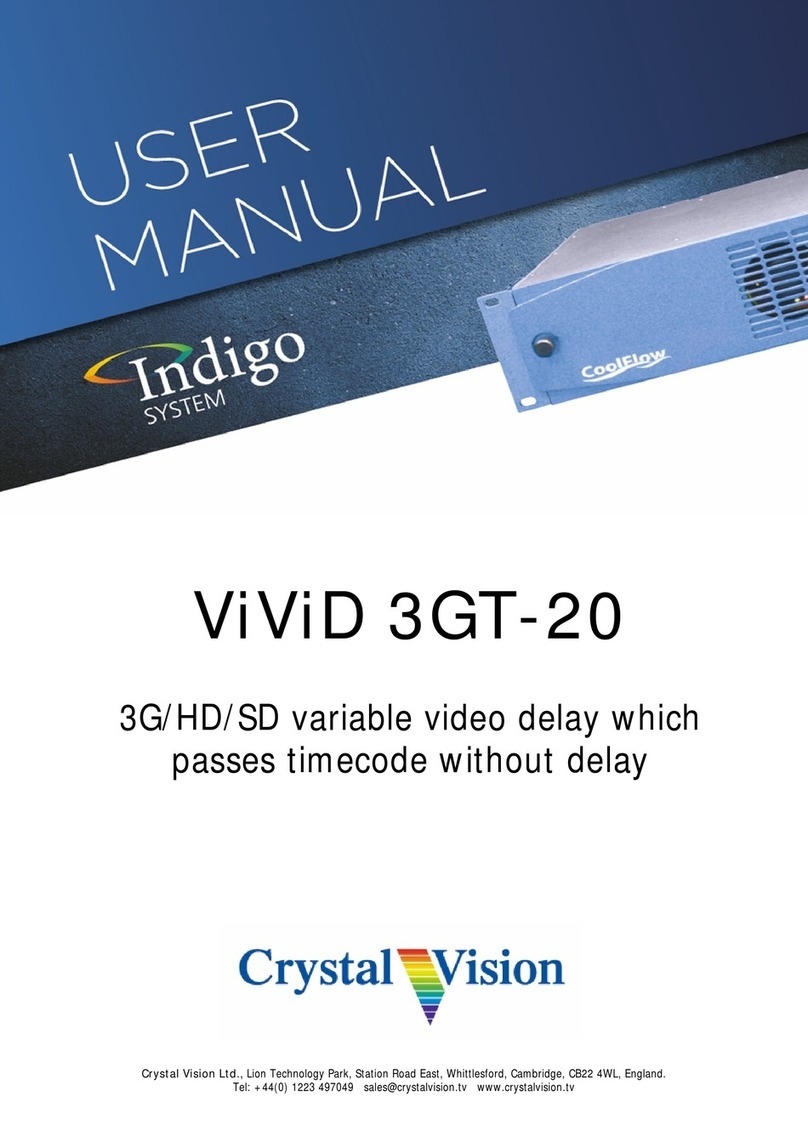
Crystal Vision
Crystal Vision Indigo ViViD 3GT-20 User manual
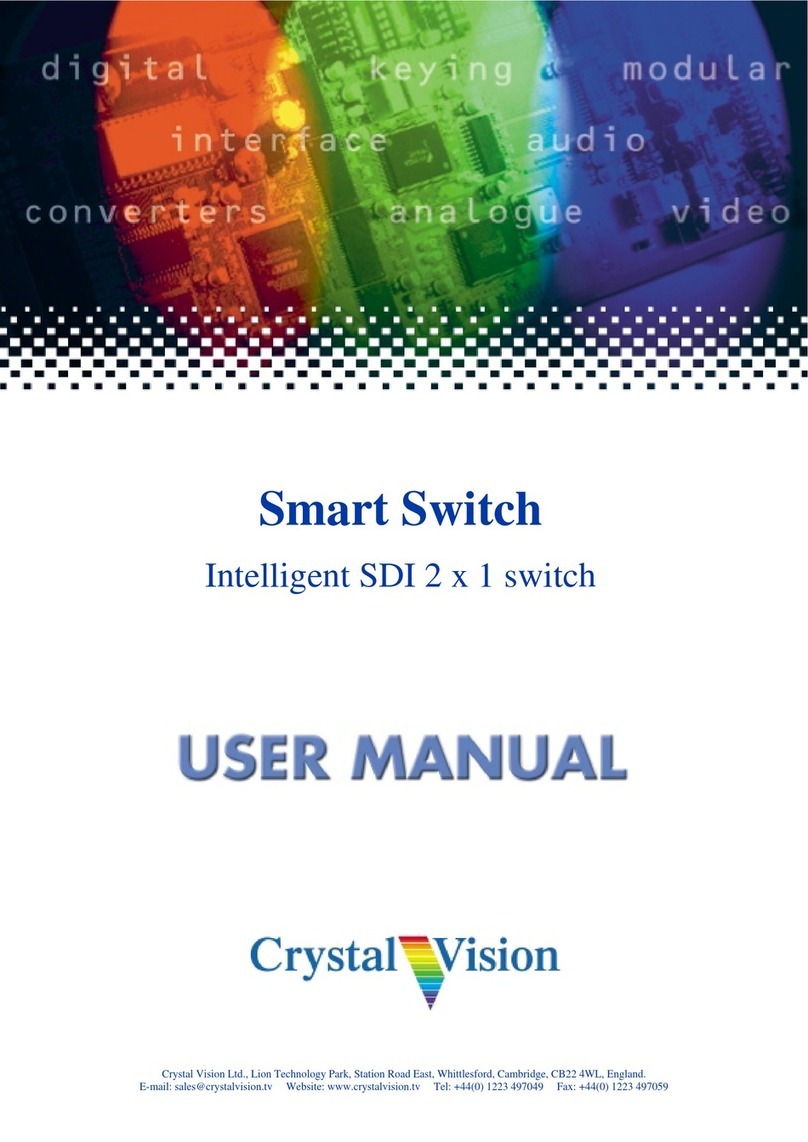
Crystal Vision
Crystal Vision Smart Switch User manual

Crystal Vision
Crystal Vision Indigo SW803 3G User manual

